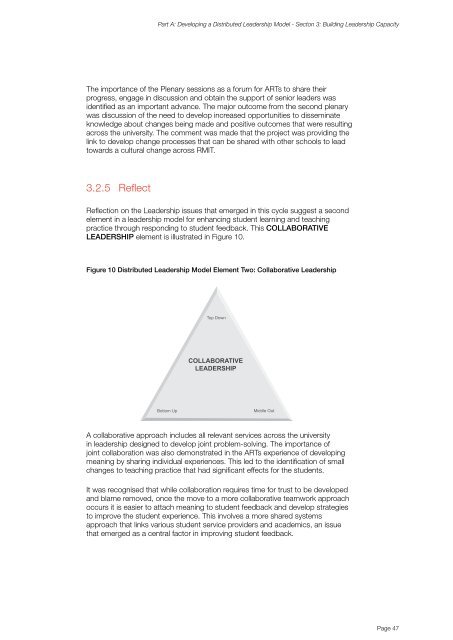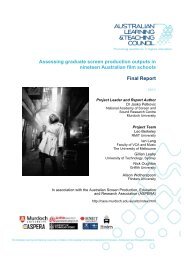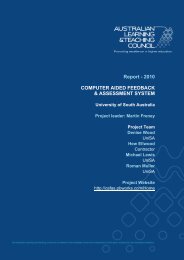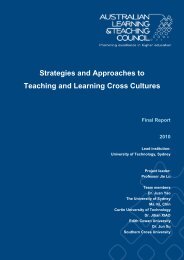student feedback and leadership - Office for Learning and Teaching
student feedback and leadership - Office for Learning and Teaching
student feedback and leadership - Office for Learning and Teaching
You also want an ePaper? Increase the reach of your titles
YUMPU automatically turns print PDFs into web optimized ePapers that Google loves.
Part A: Developing a Distributed Leadership Model - Secton 3: Building Leadership CapacityThe importance of the Plenary sessions as a <strong>for</strong>um <strong>for</strong> ARTs to share theirprogress, engage in discussion <strong>and</strong> obtain the support of senior leaders wasidentified as an important advance. The major outcome from the second plenarywas discussion of the need to develop increased opportunities to disseminateknowledge about changes being made <strong>and</strong> positive outcomes that were resultingacross the university. The comment was made that the project was providing thelink to develop change processes that can be shared with other schools to leadtowards a cultural change across RMIT.3.2.5 ReflectReflection on the Leadership issues that emerged in this cycle suggest a secondelement in a <strong>leadership</strong> model <strong>for</strong> enhancing <strong>student</strong> learning <strong>and</strong> teachingpractice through responding to <strong>student</strong> <strong>feedback</strong>. This COLLABORATIVELEADERSHIP element is illustrated in Figure 10.Figure 10 Distributed Leadership Model Element Two: Collaborative LeadershipA collaborative approach includes all relevant services across the universityin <strong>leadership</strong> designed to develop joint problem-solving. The importance ofjoint collaboration was also demonstrated in the ARTs experience of developingmeaning by sharing individual experiences. This led to the identification of smallchanges to teaching practice that had significant effects <strong>for</strong> the <strong>student</strong>s.It was recognised that while collaboration requires time <strong>for</strong> trust to be developed<strong>and</strong> blame removed, once the move to a more collaborative teamwork approachoccurs it is easier to attach meaning to <strong>student</strong> <strong>feedback</strong> <strong>and</strong> develop strategiesto improve the <strong>student</strong> experience. This involves a more shared systemsapproach that links various <strong>student</strong> service providers <strong>and</strong> academics, an issuethat emerged as a central factor in improving <strong>student</strong> <strong>feedback</strong>.Page 47
















